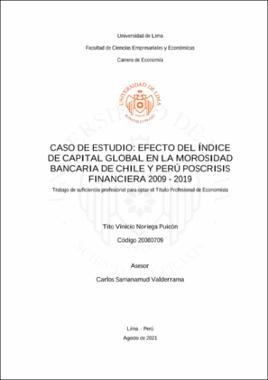Mostrar el registro sencillo del ítem
Caso de estudio: efecto del índice de capital global en la morosidad bancaria de Chile y Perú poscrisis financiera 2009 - 2019
| dc.contributor.advisor | Samanamud Valderrama, Carlos Enrique | |
| dc.contributor.author | Noriega Puicón, Tito Vinicio | |
| dc.date.accessioned | 2022-02-03T14:41:49Z | |
| dc.date.available | 2022-02-03T14:41:49Z | |
| dc.date.issued | 2021 | |
| dc.identifier.citation | Noriega Puicón T. V. (2021) Caso de estudio: efecto del índice de capital global en la morosidad bancaria de Chile y Perú poscrisis financiera 2009 – 2019 [Trabajo de suficiencia profesional para optar el Título Profesional de Economista, Universidad de Lima]. Repositorio institucional de la Universidad de Lima. https://hdl.handle.net/20.500.12724/15062 | es_PE |
| dc.identifier.uri | https://hdl.handle.net/20.500.12724/15062 | |
| dc.description.abstract | La crisis financiera internacional de 2008, conocida también como la crisis subprime, ha llegado a considerarse la mayor crisis que ha existido desde la Gran Depresión de 1929, siendo el principal gatillador de dicha crisis la falta de solvencia. Mantener niveles óptimos de solvencia es vital para la supervivencia de los bancos ante períodos de crisis o especulaciones que originarían altos niveles de morosidad. El objetivo de la presente investigación es determinar el efecto de la solvencia en la evolución de la morosidad bancaria post crisis financiera del sistema bancario de Chile y Perú, durante los años 2009 – 2019, empleando una metodología de datos de panel robusta. Las variables principales a utilizar son la morosidad bancaria, el índice de capital global, el indicador de crecimiento económico y la tasa de interés de referencia. Se concluye que el índice de capital global impacta de forma positiva y significativa a la morosidad bancaria de Chile, mientras que, en el caso del Perú, su impacto es positivo, pero no significativo. Respecto a las variables de crecimiento económico y política monetaria, se observa una relación inversa y significativa con la morosidad bancaria del Perú; en el caso de la banca chilena, se presenta esta misma relación, pero de forma no significativa. | es_PE |
| dc.description.abstract | The international financial crisis of 2008, also known as the subprime crisis, has come to be considered the biggest crisis since the Great Depression of 1929, the main trigger of this crisis being the lack of solvency. Maintaining optimal solvency levels is vital for the survival of banks in the face of periods of crisis or speculation that would lead to high levels of bank’s default rates. The objective of this research is to determine the effect of solvency on the evolution of bank’s default rates after the financial crisis in the banking system of Chile and Peru, during the years 2009 - 2019, using a robust panel data methodology. The main variables to be used are bank’s default rate, the global capital index, the economic growth indicator and the benchmark interest rate. It is concluded that the global capital index has a positive and significant impact on bank delinquency in Chile, while in the case of Peru, its impact is positive but not significant. With respect to the variables of economic growth and monetary policy, an inverse and significant relationship is observed with bank delinquency in Peru; in the case of Chilean banks, the same relationship is present, but not significantly. | en_EN |
| dc.format | application/pdf | |
| dc.language.iso | spa | |
| dc.publisher | Universidad de Lima | |
| dc.rights | info:eu-repo/semantics/openAccess | * |
| dc.rights.uri | https://creativecommons.org/licenses/by-nc-sa/4.0/ | * |
| dc.source | Repositorio Institucional - Ulima | es_PE |
| dc.source | Universidad de Lima | es_PE |
| dc.subject | Financial crises | en_EN |
| dc.subject | Economic development | en_EN |
| dc.subject | Banks and banking | en_EN |
| dc.subject | Crisis financieras | es_PE |
| dc.subject | Desarrollo económico | es_PE |
| dc.subject | Bancos | es_PE |
| dc.subject | Perú | es_PE |
| dc.subject | Chile | es_PE |
| dc.title | Caso de estudio: efecto del índice de capital global en la morosidad bancaria de Chile y Perú poscrisis financiera 2009 - 2019 | es_PE |
| dc.title.alternative | Case study: application and effect of the global capital index on bank’s non-performing loan rate in Chile and Peru post financial crisis 2009 - 2019 | en_EN |
| dc.type | info:eu-repo/semantics/bachelorThesis | |
| thesis.degree.level | Título Profesional | es_PE |
| thesis.degree.discipline | Economía | es_PE |
| thesis.degree.grantor | Universidad de Lima. Facultad de Ciencias Empresariales y Económicas, | es_PE |
| dc.publisher.country | PE | |
| dc.type.other | Trabajo de suficiencia profesional | |
| thesis.degree.name | Economista | es_PE |
| renati.discipline | 311016 | |
| renati.author.dni | 71044436 | |
| renati.level | https://purl.org/pe-repo/renati/level#tituloProfesional | * |
| renati.juror | Boitano Castro, Guillermo Rafael | |
| renati.juror | Samanamud Valderrama, Carlos Enrique | |
| renati.juror | Mello Romero, Augusto | |
| renati.type | https://purl.org/pe-repo/renati/type#trabajoDeSuficienciaProfesional | * |
| dc.subject.ocde | https://purl.org/pe-repo/ocde/ford#5.02.01 | |
| ulima.lineadeinvestigacion | 5300 - 1. B1 | |
| ulima.cat | OI |



